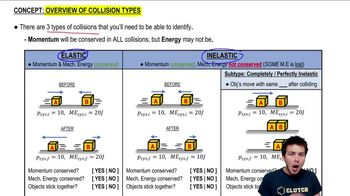11. Momentum & Impulse
Types of Collisions
Learn with other creators
Practice this topic
- Open Question
A fake hockey puck of mass 4m has been rigged to explode. Initially the puck is at rest on a frictionless ice rink. Then it bursts into three pieces. One chunk, of mass m, slides across the ice at velocity vî . Another chunk, of mass 2m, slides across the ice at velocity 2v ĵ . Determine the velocity of the third chunk.
- Open Question
A massless spring with spring constant k is placed between a block of mass m and a block of mass 3m. Initially the blocks are at rest on a frictionless surface and they are held together so that the spring between them is compressed by an amount D from its equilibrium length. The blocks are then released and the spring pushes them off in opposite directions. Find the speeds of the two blocks when they detach from the spring.
- Open QuestionA neutron is an electrically neutral subatomic particle with a mass just slightly greater than that of a proton. A free neutron is radioactive and decays after a few minutes into other subatomic particles. In one experiment, a neutron at rest was observed to decay into a proton (mass 1.67×10−²⁷ kg) and an electron (mass 9.11×10−³¹ kg) . The proton and electron were shot out back-to-back. The proton speed was measured to be 1.0 ×10⁵ m/s and the electron speed was 3.0×10⁷ m/s . No other decay products were detected.c. How much momentum did this neutrino 'carry away' with it?
- Open QuestionThe nucleus of the polonium isotope ²¹⁴Po (mass 214 u) is radioactive and decays by emitting an alpha particle (a helium nucleus with mass 4 u). Laboratory experiments measure the speed of the alpha particle to be 1.92×10⁷ m/s . Assuming the polonium nucleus was initially at rest, what is the recoil speed of the nucleus that remains after the decay?





